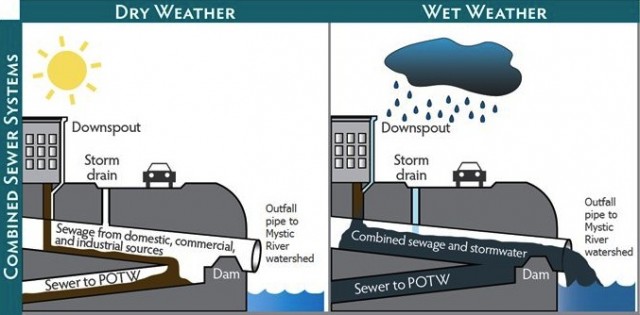We wash our dishes, take our showers, and flush our toilets without giving the water that runs through our homes a second thought. As residents of New York City, our extensive, miraculous water system provides us (and our 8 million neighbors) with 1.3 billion gallons of water a day.
But where does water go, once past the kitchen sink? Occasionally the city’s waste water makes itself evident in our daily routine; along some waterways after a particularly intense rain storm, the air is heavy with the barnyard odor of combined sewage overflow. That’s the effect of raw sewage being released into the harbor when storm drains overwhelm the city’s sewer system.
The issue of combined sewage overflow has been at the forefront of NYC Department of Environmental Protection’s concerns for quite some time. The problem comes from a centuries old system operating at maximum, handling billions of gallons of waste water every day.
Most days work fine, but New York City has what is a called a combined sewer, a system that collects a neighborhood’s sewage or wastewater as well as storm water runoff into one single pipe. A common characteristic of cities with old infrastructure, this sewage includes wastewater from domestic sources, biological contaminants, as well as commercial and industrial surface runoff.
The system is built to collect all the water (rain runoff and sewage) and direct it to one of 14 publicly owned treatment facilities. There large particles, chemicals, and biological pollutants are removed. The drawback with this type of drainage is that when there is an excessive amount of rain, it floods the system, overflow pipes are reached, and to keep from swamping the treatment plants, everything is released, untreated, into our rivers, canals, and harbor.
There are 460 CSO pipes discharging up to 30 billion gallons of sewage and storm water from the city’s sewer system each year after heavy rain events. This water not only includes those chemicals noted from industrial work, but also biodegradable material that can harm the ecological balance of our waterways.
The common fix for this problem is to create gray infrastructure, including water storage tanks and facilities, that can store the excess water and release it back into the system to be properly treated once the storm has ended, a remedy that could cost the city upwards of 6.8 billion dollars.
In September 2010, New York City unveiled its Green Infrastructure Plan which makes use of green technologies along with gray infrastructure.  The central part of the green infrastructure plan is to use vegetation (trees and green spaces, bioswales), porous pavements and streets, rain barrels, and green and blue roofs to augment the conventional gray infrastructure methods. The goal is to absorb and slow heavy downpours with a more porous streetscape, so that rain runoff doesn’t trigger untreated discharge.
The central part of the green infrastructure plan is to use vegetation (trees and green spaces, bioswales), porous pavements and streets, rain barrels, and green and blue roofs to augment the conventional gray infrastructure methods. The goal is to absorb and slow heavy downpours with a more porous streetscape, so that rain runoff doesn’t trigger untreated discharge.
This plan will not only help the city solve this very important issue, but offers additional benefits including reduced urban heat island effect, improved energy efficiency, cleaner air for New Yorkers, increase in property values, possible sources for fruits and vegetables, as well as an enhanced quality of life due to a increase in green space.
 The largest parts of the program are the installation of bioswales and green streets. The goal is to increase acreage of these storm water processing areas by 2030 a total of 10%, with certain waterbodies being prioritized for application of adjacent green infrastructure. Private property is also being targeted through a special grant program that awards an average of 5 million dollars a year for implementation of an assortment of green technologies. Through these combined efforts the city hopes to save 1.3 billion dollars and help deflect 12 billion gallons of untreated waste water over the next 20 years.
The largest parts of the program are the installation of bioswales and green streets. The goal is to increase acreage of these storm water processing areas by 2030 a total of 10%, with certain waterbodies being prioritized for application of adjacent green infrastructure. Private property is also being targeted through a special grant program that awards an average of 5 million dollars a year for implementation of an assortment of green technologies. Through these combined efforts the city hopes to save 1.3 billion dollars and help deflect 12 billion gallons of untreated waste water over the next 20 years.
The Green Infrastructure Plan and the team implementing it are taking one of the nation’s oldest cities (with the largest urban water system) and upgrading it for better performance in the future. (Old, but not as old as Rome.) CSO events will still happen, but thoughtful design can blunt the worst. And on ordinary days, we’ll still forget about all of the city’s plumbing as we wash the dishes, but it’s good to know it’s there.
For more about the past and future of New York’s miraculous water system, read our interview with scientist Allan Frei.
Bioswale in real life:
Lastly, where does our waste go after it’s been successfully processed by a treatment plant? (It’s dehydrated and shipped off to landfill.) If you work or live by the East River, you may have seen a DEP freighter plying the waterway on a steady routine, and here is a lovely explanation from the blog NYC Strength.


1 Comment
Comments are closed.